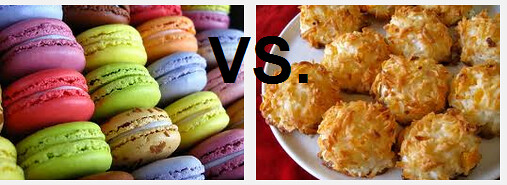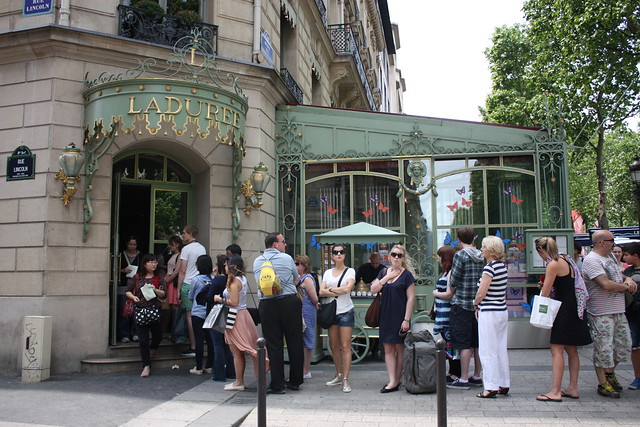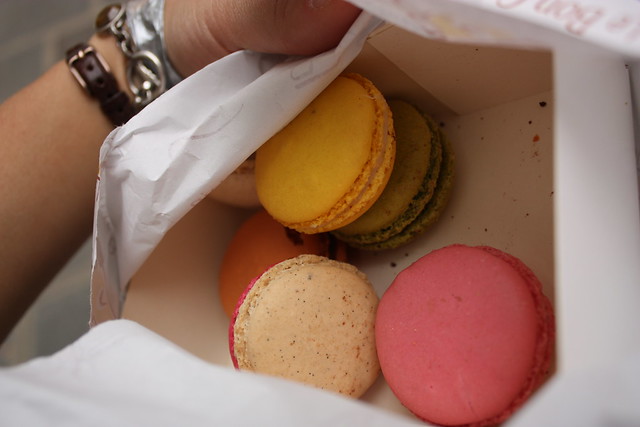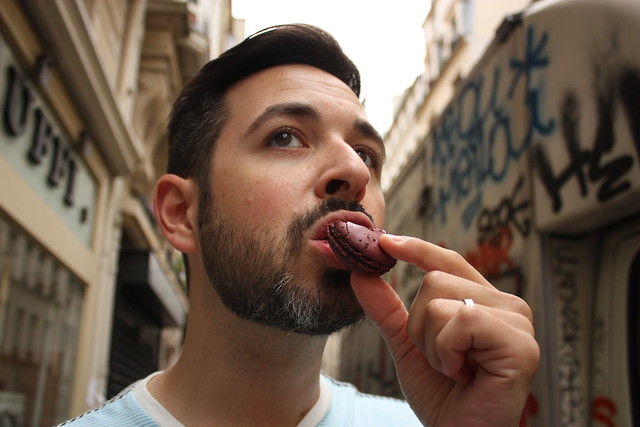Macarons in Paris
For many years, I didn’t really get macarons.

–
{For those who have devoted less of their waking hours to the study, acquisition, and consumption of baked goods, I would like to take a brief moment to delineate French “macarons” from “macaroons”. While it is, essentially, the same word (one is the French variant, the other the English), here in the states they mean two very different things. The former is a sandwich cookie of French origin, made from egg whites, almonds, and sugar. A multitude of flavors and colors can be added to the batter, to compliment the filling that is smooshed between the halves. (I’ve encountered such awesome macaron fillings as: Nutella, frosting, dulce de leche, homemade fruit preserves, and PURE MAGIC). The latter is cookie composed of shredded coconut, sugar, and egg whites. I’ve made coconut macaroons for Passover before, and the consensus was that they were a teeny step up from eating burnt cookies.}

Interestingly, a image search for “macaroons” yielded pictures of both. Which made creating this graphic really easy. MS PAINT 4 EVA.
–
The appeal of these little confections eluded me for years; macarons seemed like snobby Oreos, frankly. I’d see them in the case at Le Panier, the French bakery in the Pike Place market, and disregarded them handily. Nothing that pretty, I decided, could taste good. And besides, the prices were obscene. $2.00 for a tiny little sandwich cookie? I can get a snickerdoodle THE SIZE OF MY FACE for that kind of cash.

These are not the size of my face, and they cost $50.
–
Which was usually what I did.
The first time I can actually remember eating and enjoying a macaron was in South Africa, during our tea times at the Kloof. Since food was included in the price of our stay, I could not scoff at the cost of an individual macaron (it was, depending on how you looked at it, either free or really, really pricey). Besides, there were no snickerdoodles to speak of in South Africa.
So I decided to try one, and madness ensued almost immediately. Here is what happened:
- I took a bite. It was both crisp and chewy, delicate and bursting flavorful all at once. I don’t know how something so insubstantial could have such a presence, but I imagined that if we could eat daydreams, they would taste like this.
– - I declared it one of the best things that I’d ever had in my mouth. (That’s what she said.)
– - I stared at it sadly, told Rand I couldn’t eat any more of it, and passed the cookie to him.
You are probably rereading that last point, and trying to make sense of it. And … well, there’s really no sense to be made of it. It’s just … I’d gone so long avoiding macarons, and now I had finally eaten one, and it was unbelievably delicious. And I … I just couldn’t take it. I didn’t want to admit how much time I’d squandered NOT eating macarons.
It was easier to just hand it off to Rand.
Fear not: this reaction was temporary, and by the time we got to Paris, it was gone. I understood, and had seen the light: I was ready to eat macarons. Indeed, I’d taken several weeks of French lessons so that I would know precisely how to order a box of them (in several assorted flavors).
I can barely utter two words in French, but if you saw me in a Parisian pastry shop, you’d swear I was fluent. Screw phrases like “Can you please direct me to my hotel?” and “I am in dire need of medical attention.” Who needs those when you’ve absolutely perfected, “Good day! I would like six macarons, please. Two vanilla, two chocolate, and …”?
(Note: I can do the same thing when it comes to eclairs, because I am a survivalist.)
In Paris, you’ll find a number of shops that specialize in macarons. Ladurée, which has been in operation since 1862, is arguably the most famous, and with good reason: the macaron as we know it today was born at Ladurée in the 1930s (prior to then, no one had thought of sandwiching a layer of ganache between the cookies. IT WAS BASICALLY THE DARK AGES).
I’m pretty proud to say that 80 years later, I finally caught on to what everyone else already knew.
The crowds and the prices you will have to endure are commensurate with the chain’s popularity. Here’s the line outside of the shop on the Champs-Élysées:

–
They even have an outpost in Charles de Gaulle airport. The shops offer dozens of flavors, from the traditional (vanilla and chocolate) to the innovative (salted caramel, strawberry mint). My favorites proved to be the caramel (which had a dulce de leche type filling that I stared at lovingly for just long enough for it to be weird) and the rose petal, which was delicate and beautiful (and, let’s be fair, how often, as an adult, do you get to eat pink dessert? NOT OFTEN ENOUGH, PEOPLE.)
You will pay more for the treats at Ladurée, because you are paying for the name, and the pedigree, and the beautiful box in which they are packaged.
And while the macarons there were very, very good, I don’t know if there were better than the ones we got from a small, no-name shop somewhere in the 4th arrondissement. The woman behind the counter wrapped them in a small box with plain white paper, and she threw in one extra for me (“Citron,” she said, which was her favorite) when she saw how committed I was to ordering in French.

–
And despite the simplicity of the packaging and the relative invisibility of the shop, they were perfect:

–
We ate them while standing in the street in Marais, and the sky began to threaten rain.

–

–
There’s a point, I’m sure, for every great philosopher and scientist, where things fall into place. A light bulb goes on overhead, and everything makes sense. The theory of relativity emerged for Einstein, the blueprints for the rotary engine dawned upon Barney Coopersmith.
As my achievements are not so lofty, my biggest revelations have to do with dessert. One day, not all that long ago, I ate a macaron, and understood for the first time what they could be.

This is my “I’ll cut you if you try to take my cookie from me” face. I make it all the time.
–
And I haven’t looked back since.









Leave a Comment